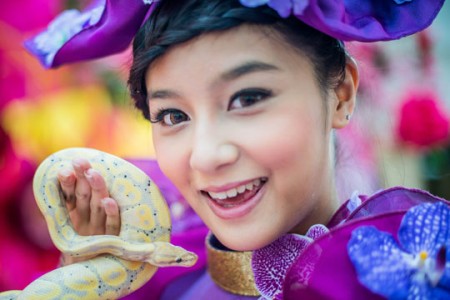I am not sure really what this article is about. I have to admit that it seems part yearly horoscope, part restaurant review, part dating advice, with just a hint of herbal remedy, and some fashion advice thrown in for good measure. I am not even certain it belongs here, but that being the case then it probably does. Let’s have a look.
From Japan Times
Men Shouldn’t Fear Seductive Snake Women This Year
By KAORI SHOJI
Did you have a hatsuyume (初夢, first dream of the new year) and did it involve hebi (蛇, snakes)? If the answer is yes to both, omedetō gozaimasu (おめでとうございます, congratulations), you’ve hit the jackpot, at least on the unsei (運勢, fortune and destiny) front for the coming year. Hebidoshi (巳年, The Year of the Snake) has officially kicked in, and though this particular jūnishi (十二支, 12 signs of the Chinese zodiac) symbol isn’t blessed with the same cute, accessible image as say, the u (卯, rabbit) or ne (子, mouse), there’s plenty of good stuff to say about it. On the archipelago the snake is known to have reiryoku (霊力, spiritual powers) and dreams with snakes in them signify future prosperity, or at least a windfall — maybe as early as next week.This is what I keep telling my friend Sayuri, a toshionna (年女, a woman born in a year with the same animal sign as the current year) who has routinely denied the fact these past couple of years. “Who wants to date a hebionna (蛇女, snake woman) in this day and age of sōshoku danshi (草食男子, herbivore men)?” is the reason for her denial. To curb any revealing hebionna traits, Sayuri has decided to switch to jimi-meiku (地味メイク, inconspicuous make-up) throughout the year. Nothing with glitter and very little on the gloss. No coiling her hair on top of her head. No lounge lizard-y pants over snakeskin boots. “Hebi wo rensō saseru mono wa zenbu dame” (「蛇を連想させるものは全部ダメ」, “Anything that suggests snakes is a no-no”) she says, and has even thrown out her leopard-skin mules, despite me telling her they were mammalian, not reptilian.
According to Sayuri, the hebidoshi no onna (巳年の女, woman of the snake year) can’t be too careful. After all, the snake woman is famed for having a libido the size of an ocean liner and is the most possessive of the 12 signs, preferring to strangle a lover than let him leave her. Though this could be the ultimate turn-on elsewhere on the globe, unfortunately in this country the degree of tanpaku (淡白, indifference) among the danshi (男子, men or boys) cannot be overestimated. I know my own brother would suffer from brain-cell asphyxiation at the mere thought of a possessive, libidinous snake woman ordering him to put down the iPad, strip off his pajamas and get into bed.
Though snake dreams are deemed generally good, having a bunch of snakes (all coiled up and slithering in a basket) appear in the subconscious has been known to indicate a secret penchant for debauchery and corruption. When more than three snakes appear in one dream, beware: You are about to succumb to yūwaku (誘惑, seduction), sexual or otherwise, potentially jeopardizing your chances for stability and happiness. The best snake dream of all involves a single shirohebi (白蛇, white snake) — believed to be a benevolent money goddess. If you’ve had the white snake dream, the only sane course of action is to sprint toward the nearest takarakuji (宝くじ, lottery) booth and buy a wad of tickets. And remember me if you win.
Sayuri has all the lauded snake qualities, such as genuine sincerity, a good head for business and a wish to see her family prosper. She is a jō ni atsui onna (情に篤い女, compassionate and emotional woman) and paradoxically has trouble finding a man worthy of her expansive and generous personality. The hebiotoko (蛇男, man born in the year of the snake) is often a disappointment, she says, since snake men are known for being tōsōteki (闘争的, argumentative) and seifukuyoku ga tsuyoi (征服欲が強い, having a strong desire to conquer). Sayuri complains: “They want to fight over little details, like whether or not to have beer before dinner, and who should pay for it.” Generalizations shouldn’t be taken seriously but to the Japanese, the jūnishi assessments are fun to bat around and match up. Many place more faith in the jūnishi than in Western horoscopes, and though the ketsuekigata (血液型, blood type) assessment boom comes and goes, the jūnishi is pretty much forever.
Back to the snake itself, it’s also known for extreme restorative/rejuvenating powers and has been used in liquor (the snake is killed, then fermented in sake or shōchū) since the days of the Heian Era (平安時代, 794-1192). During the Edo Period, there were a number of restaurants specializing in snake dishes, as they were known to be a strong kyōseiyaku (強精薬, aphrodisiac tonic). Not surprisingly, snake dishes were banned from most jiin (寺院, temples) for having an evil influence on the sōryo (僧侶, monks), though they were sometimes used for medicinal purposes.
Today, it’s possible to dine on a bit of snake in one of two remaining hebiryōri senmonten (蛇料理専門店, restaurants specializing in snake) in Tokyo, but the custom of partaking in snake has all but died out. Rejuvenation and prosperity are nice to have but I guess we’re not that desperate.
Got all that? I think there was a part about someone hitting the lottery and meeting a snake lady that is also a fashion designer who might strangle him any second (so presumably they got married somewhere along the story) and is a dominatrix. Then a snake man shows up, I think it was her ex because he was drinking beer, and he does horoscopes and runs an apothecary shop, and they all went out to dinner.
Please explain it to me






